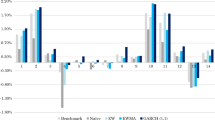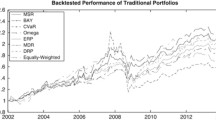Abstract
In this paper we test the effects of temporal aggregation (disaggregation) on the efficiency of portfolio construction using the mean variance optimization approach. Using Monte Carlo techniques and empirical data from the Athens Stocks Exchange we confirm that the use of temporally aggregated data effects very seriously the efficiency of the constructed portfolio. Especially as the degree of temporal aggregation increases the application of optimization techniques could lead to different results regarding the percentage of stocks participation, the weights and finally the total portfolio performance.
Similar content being viewed by others
Reference
Alexakis, P. and Petrakis, P., (1991), Analysing Stock Market Behaviour in a Small Capital Market, Journal of Banking and Finance, Vol. 15, pp. 471–83.
Amemiya, T. and R.Y. Wu (1972), The Effect of Aggregation on Prediction in the Autoregressive Model, Journal of the American Statistical Association, No. 339, 628–632.
Apergis, N. and Eleptheriou, S., (2001), Stock Returns and Volatility: Evidence from the Athens Stock Market Index, Journal of Economics and Finance, Vol. 25, pp. 50–61.
Barkoulas, J.T. and Travlos, N.G., (1998), Chaos in an Emerging Capital Market? The Case of the Athens Stock Exchange, Applied Financial Economics, Vol. 8, pp. 231–243.
Barkoulas, J.T., Baum, C.F. and Travlos, N.G., (2000), Long Memory in the Greek Stock Market?, Applied Financial Economics, Vol. 10, pp. 177–184.
Bletsas, A. (1983), Rates of Return on Investments in the Athens Stock Exchange: 1955–1975, Greek Economic Review, Vol. 4, pp. 242–254.
Brewer K.R.W., (1973), ‘Some consequences of temporal aggregation and systematic sampling for ARIMA and ARIMAX models’, Journal of Econometrics, 1, pp. 133–154
Courts, J.A., Kaplanidis, C. and Roberts, J., (2000), Security Price Anomalies in an Emerging Market: The Case of the Athens Stock Exchange, Applied Financial Economics, Vol. 10, pp 561–571.
Demos, A. and Parissi, S., (1998), Testing Asset Pricing Models: The Case of the Athens Stock Exchange, Multinational Finance Journal, Vol. 2, pp. 189–223.
Di Fonzo Tommaso (2003)., Temporal disaggregation of economic time series: towards a dynamic extension., Luxembourg: Office for Official Publications of the European Communities, 2003
Doumpos, M. and Zopounidis, C., (2002). Multicriteria Decision Aid Classification Methods., Kluwer Academic Publishers, Dordrecht.
Elton Edwin & Gruber Martin.,(1977)., Modern portfolio theory, 1950 to date., Journal of Banking and Finance., 1977., pp. 1743–1759.
Engle, R.F. (1969), Biases from Time-Aggregation of Distributed Lag Models, Ph.D. Dissertation, Cornell University.
Granger, C.W.J., and T.-H. Lee (1999), The Effect of Aggregation on Nonlinearity, Econometric Reviews, 18, 259–269.
Granger C.W.J. and. Siklos, P.L., (1995). ‘Systematic sampling, temporal aggregation, seasonal adjustment, and cointegration: Theory and evidence’,Journal of Econometrics, 66, pp. 357–369
Grinblatt M., Titman S., (1989), Portfolio Performance Evaluation: Old Issues and New Insights, The review of Financial Studies, Vol 2, No 3 (1989), pp 393–421, http://rfs.oupjournals.Org/cgi/reprint/2/3/393
Karathanassis, G. and Philippas, N.,(1993), The Use of Error Components Models in Business Finance: A Review Article and an Application, Spoudai, Vol. 43, pp. 95–110.
Kirikos, D., (1996), Risk Aversion and the Efficient Markets Model for Stock Prices: Evidence from the Athens Stock Exchange, in Doukas, J. and Lang, L., eds., Research in International Business and Finance, Supplement 1, pp. 279–295, London, JAI Press.
Koutmos, G., Negakis, C. and Theodossiou, P., (1993), Stochastic Behaviour of the Athens Stock Exchange, Applied Financial Economics, Vol. 3, pp. 119–126.
Laopodis, N. (1997), Distributional Properties and Weekly Return Patterns of the Athens Stock Exchange, Applied Economics Letters, Vol. 4, pp. 769–774.
Marcellino, M. (1999), Some Consequences of Temporal Aggregation in Empirical Analysis, Journal of Economic and Business Statistics, 17, 129–136.
Markowitz, H. M. (1959)., Portfolio Selection: Efficient Diversification of Investments, New York: John Wiley and Sons.
Mertzanis, H. and Siriopoulos, C., (1999), Financial Regulation and Stock Market Volatility in the Athens Stock Exchange, Economia Internazionale, Vol. 52, pp. 191–213.
Milionis, A.E., Moschos, D., and Xanthakis, M., (1998), The Influence of Foreign Markets on the Athens Stock Exchange, Spoudai, Vol. 48, pp 140–156.
Milonas, N.T., (2000), Similarly Traded Securities: Greek Common vs. Preferred Stock, European Financial Management, Vol. 6, pp. 343–366.
Niarchos, N. and Alexakis, C., (1998), Stock Market Prices, ‘Causality’ and Efficiency: Evidence from the Athens Stock Exchange, Applied Financial Economics, Vol. 8, pp. 167–174.
Papachristou, G., (1999), Stochastic Behaviour of the Athens Stock Exchange: A Case of Institutional Nonsynchronous Trading, Applied Financial Economics, Vol. 9, pp. 239–250.
Papaioannou, G.J., Travlos, N.G. and Tsangarakis, N.V., (2000), Valuation Effects of Greek Stock Dividend Distributions, European Financial Management, Vol. 6, pp. 515–531.
Quenouille, M.H. (1957), The Analysis of Multiple Time Series, London: Griffin.
Rossana R.J. and Seater, J.J., (1995). ‘Temporal aggregation and economic time series’,Journal of Business and Economic Statistics, 13, pp. 441–451
Stram, D.O. and W.W.S. Wei (1986), Temporal Aggregation in the ARIMA Process, Journal of Time Series Analysis, 7, 279–292
Tiao, G.C. (1972), Asymptotic Behaviour of Temporal Aggregates of Time Series, Biometrika, 59, 525–531.
Tserkezos D., Georgutsos D. and Kouretas G., (1998)., ‘Temporal Aggregation in Structure VAR Models.’ Applied Stochastic Models and Data Analysis, 14, pp. 19–34
Wei, W.W.S. (1990)Time Series Analysis: Univariate and Multivariate Methods. Addison-Wesley, California.
Weiss, A.A. (1984) Systematic sampling and temporal aggregation in time series models,Journal of Econometrics, 26, 271–281.
Zellner, A. and Montmarquette, C. (1971) A study of some aspects of temporal aggregation problems in econometric analyses,Review of Economics and Statistics, 63, 335–342.
Author information
Authors and Affiliations
Rights and permissions
About this article
Cite this article
Xanthos, G., Tserkezos, D. Temporal aggregation effects on the construction of portfolios of stocks or mutual funds through optimization techniques. Some empirical and Monte Carlo results. Oper Res Int J 7, 61–82 (2007). https://doi.org/10.1007/BF02941186
Issue Date:
DOI: https://doi.org/10.1007/BF02941186
Keywords
- Portfolio Optimization
- Stocks
- Temporal Aggregation
- Stochastic Simulation
- The Banking Sector of the Athens Stocks Exchange




